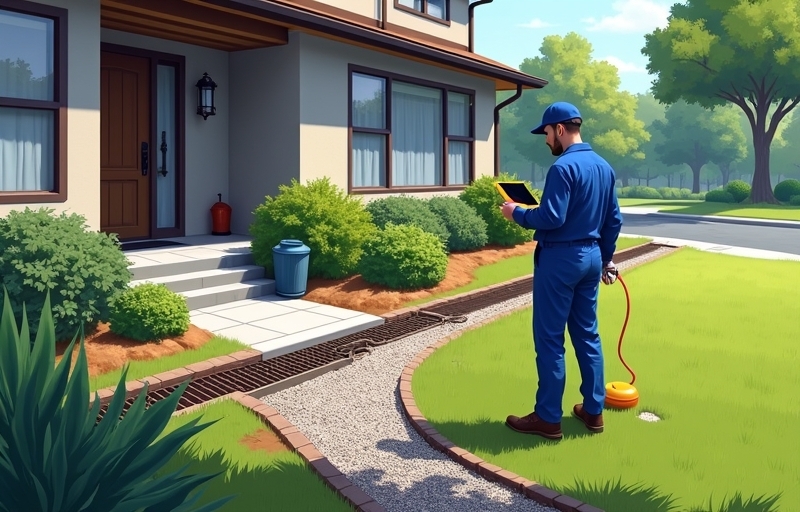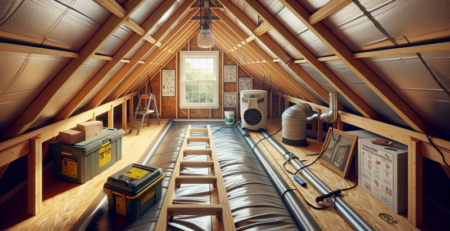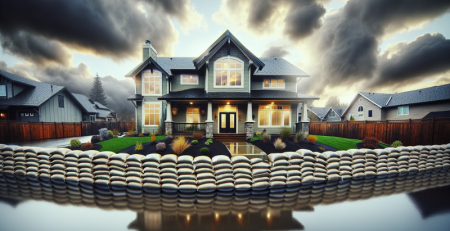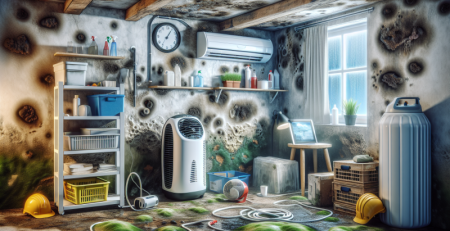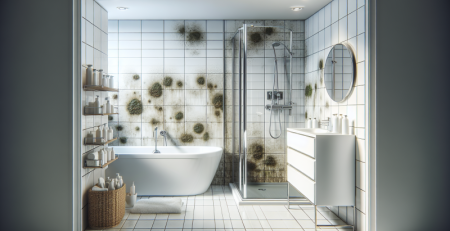Water Damage: How to Prevent Flooding in Your Yard
Is your yard turning into a swamp every time it rains? Flooding can cause severe water damage, leading to soil erosion, plant loss, and even foundation issues. At [Kraus Restoration](https://krausrestoration.com/), we specialize in protecting homes from water damage, offering expert solutions to keep your property safe.
The key to preventing yard flooding lies in proper drainage, landscaping adjustments, and regular maintenance. Installing French drains, grading your yard correctly, and maintaining gutters can significantly reduce water buildup. Experts like the IICRC-certified team at Kraus Restoration recommend proactive measures to prevent costly repairs and long-term damage.
But there’s more to it than just drains and slopes. Understanding the causes of flooding and implementing the right solutions can save you thousands in repairs. Let’s explore the best strategies to keep your yard dry and your home protected.
Understanding Water Damage and Its Impact
Water damage occurs when excess water infiltrates a property, leading to structural deterioration and potential health hazards. It weakens foundations, damages walls, and promotes mold growth. Left untreated, it can compromise the safety of a home and reduce its value.
Several factors contribute to water damage in residential areas. Heavy rainfall, poor drainage, and clogged gutters often lead to flooding. Leaking pipes, faulty appliances, and roof damage also allow water to seep into walls and floors. Even minor leaks can escalate into severe structural issues over time.
The financial burden of water damage can be overwhelming. Repair costs for structural damage, mold remediation, and damaged belongings add up quickly. Homeowners may also face increased insurance premiums and decreased property value. Beyond finances, prolonged exposure to moisture weakens materials, leading to costly repairs.
Preventative measures can help protect homes from extensive damage. Regular maintenance and timely repairs reduce risks significantly. If water damage occurs, professional water cleanup services ensure proper restoration. For long-term protection, consulting experts from trusted restoration companies can provide effective solutions.
Common Causes of Yard Flooding
Heavy rainfall overwhelms the ground, causing water to pool. Poor drainage systems fail to redirect excess water, leading to standing water issues. Certain soil types, like clay, retain moisture, preventing proper absorption. These natural factors contribute to persistent yard flooding.
Human-made issues also play a role. Improper landscaping disrupts natural water flow, creating low spots where water collects. Clogged gutters prevent rainwater from draining properly, forcing it to spill over and saturate the ground. Faulty irrigation systems leak or overwater, increasing soil saturation and runoff.
For example, a homeowner with compacted soil and a sloped yard may experience frequent flooding. Water runs downhill, pooling near the foundation and causing damage. Similarly, a neglected gutter system can overflow, leading to erosion and standing water. Poorly designed landscaping without proper drainage channels worsens the issue.
Addressing these problems early can prevent costly repairs. Professional water cleanup services help mitigate damage. If flooding leads to mold growth, expert mold cleanup ensures a safe environment. For long-term solutions, consulting with residential design professionals can improve drainage and prevent future issues.
Assessing Your Yard’s Flood Risk
Start by observing how water flows during heavy rain. Check if puddles remain for hours after rainfall. Standing water indicates poor drainage. Look for areas where soil washes away, as erosion signals improper runoff. Examine your yard’s slope to see if water moves away from structures.
Walk around your property and inspect gutters and downspouts. Ensure they direct water at least five feet from your home. Clogged gutters can cause overflow, leading to water pooling near the foundation. Test soil absorption by digging a small hole and filling it with water. If it drains slowly, your yard may have compacted soil.
Identify low spots where water collects. These areas may need regrading or drainage solutions. Check nearby storm drains for blockages that could back up water. If you notice persistent issues, consider professional help. Experts from water cleanup services can assess and improve drainage.
Regular maintenance prevents severe damage. If you need assistance, reach out through the contact page. Proper evaluation helps protect your home from flooding risks.
Landscaping Techniques to Prevent Flooding
Proper grading and sloping ensure water flows away from your home, preventing structural damage. A well-graded yard directs runoff toward drainage areas, reducing pooling. Sloping the ground away from foundations minimizes the risk of water infiltration.
Rain gardens help absorb excess water, reducing surface runoff. These gardens use deep-rooted native plants to improve soil absorption. Native plants require less maintenance and thrive in local conditions. They also enhance biodiversity while managing stormwater naturally.
Permeable surfaces like gravel and pavers improve drainage by allowing water to seep into the ground. Unlike solid concrete, these materials prevent water buildup and reduce erosion. Installing permeable pathways and driveways enhances water absorption. Proper placement of these surfaces ensures effective drainage without compromising aesthetics.
For professional assistance, explore our services to safeguard your property. Our residential design solutions help create flood-resistant landscapes. Contact us today through our contact page for expert guidance.
Installing Effective Drainage Systems
Proper drainage prevents water buildup and protects your yard from flooding. French drains, dry wells, and swales are effective solutions. A French drain redirects water using a perforated pipe buried in gravel. It works best for areas with poor soil drainage. Dry wells collect excess water and slowly release it into the ground, ideal for handling runoff from gutters. Swales are shallow ditches that guide water away while promoting absorption.
To install a basic system, start by identifying problem areas. Dig a trench where water accumulates and line it with landscape fabric. Add a layer of gravel before placing a perforated pipe. Cover the pipe with more gravel and fold the fabric over it. Finally, top it with soil or decorative stones. Regular maintenance ensures efficiency.
For professional assistance, explore our services. Our team specializes in water damage solutions. Check out our residential design projects for inspiration. Need expert advice? Visit our contact page to get started.
Maintaining Gutters and Downspouts
Gutters and downspouts play a crucial role in directing rainwater away from your yard. When they function properly, they prevent water from pooling around your home’s foundation. Clogged or damaged gutters can lead to overflow, causing erosion and potential flooding issues.
Regular maintenance is essential to keep them working efficiently. Clean gutters at least twice a year to remove leaves, dirt, and debris. Inspect for leaks, rust, or sagging sections that could disrupt water flow. Secure any loose fasteners and ensure proper alignment to prevent overflow. If you notice persistent issues, consider professional water cleanup services.
Extending downspouts is another effective way to prevent water damage. Use extensions or splash blocks to direct water at least five feet away from the foundation. This helps prevent soil erosion and basement leaks. If necessary, install underground drainage pipes for better water management. Properly maintained gutters and downspouts protect your home and landscape from costly damage. For expert assistance, explore our services or contact us today.
Managing Excess Water with Rain Barrels and Retention Ponds
Rain barrels capture runoff from roofs, storing it for future use. They help reduce water waste and prevent yard flooding. Installing them under downspouts ensures efficient collection. A secure lid keeps debris and pests out. Regularly cleaning filters and checking for leaks maintains functionality.
Retention ponds manage excess water in large yards by slowing runoff and allowing gradual absorption. They prevent erosion and improve drainage. Adding native plants around the pond enhances filtration and supports local wildlife. Proper grading ensures effective water flow. Routine maintenance, such as removing debris and controlling algae, keeps the system efficient.
Both solutions offer sustainable water management. Rain barrels provide a free water source for irrigation, reducing utility costs. Retention ponds enhance landscape aesthetics while preventing water damage. For professional assistance, explore our water cleanup services. Our team ensures effective solutions tailored to your needs. Learn more about our residential design projects for optimized drainage systems. If you need expert guidance, visit our contact page to get started today.
Preventing Flooding with Smart Irrigation Practices
Overwatering saturates the soil, preventing proper absorption and leading to excess runoff. This runoff collects in low areas, increasing the risk of yard flooding. Smart irrigation systems help regulate water usage by adjusting based on soil moisture levels. Installing rain sensors ensures sprinklers don’t activate during or after rainfall, preventing unnecessary watering.
Watering at optimal times reduces waste and improves absorption. Early morning is ideal since temperatures are lower, minimizing evaporation. Avoid watering in the evening, as excess moisture can promote mold growth. Using drip irrigation directs water to plant roots, reducing runoff and maximizing efficiency.
Regular maintenance of irrigation systems prevents leaks that contribute to oversaturation. Adjust sprinkler heads to avoid watering driveways or sidewalks. Consider landscaping solutions like rain gardens or permeable surfaces to improve drainage. If flooding persists, professional water cleanup services can help mitigate damage.
For expert assistance, explore our services or view our residential design projects for effective drainage solutions.
Emergency Measures for Sudden Flooding
Act fast when water starts rising. First, move valuables and electronics to higher ground. Shut off electricity if it’s safe. Use sandbags to block entry points and direct water away from your home. Stack them tightly, overlapping each layer for stability. Temporary barriers like plastic sheeting or water-filled tubes can also help.
Ensure gutters and drains remain clear to allow proper water flow. Avoid walking through floodwater; it may contain debris or contaminants. If water levels continue rising, evacuate immediately. Contact professionals for water cleanup to prevent further damage.
Monitor weather updates and follow local emergency alerts. If structural damage occurs, avoid entering affected areas. Seek expert assistance for mold cleanup to prevent health risks. After the flood subsides, inspect your property carefully. Document damages for insurance claims and begin drying out affected areas.
For extensive damage, reach out to professionals to restore your home safely. Taking swift action minimizes risks and prevents long-term issues.
Frequently Asked Questions (FAQs)
Poor drainage signs include standing water, soggy soil, and erosion. Clay-heavy soil retains water, increasing flood risks. Loamy soil offers the best drainage, reducing excess moisture. Fixing yard flooding without professional help is possible with proper grading, rain gardens, or installing a French drain. Cleaning gutters at least twice a year prevents water buildup and potential damage.
Cost-effective drainage improvements include adding mulch, extending downspouts, and using gravel trenches. Low-lying yards require strategic landscaping, such as raised beds or swales, to redirect water. Directing water away from your home’s foundation involves installing downspout extensions and grading the soil properly.
Plants like ferns, willows, and ornamental grasses absorb excess water efficiently. A French drain helps with water management but may not solve all flooding issues. If your yard floods frequently, consider consulting professionals for effective solutions. Learn more about our water cleanup services.
For expert assistance, explore our residential design solutions. Need immediate help? Visit our contact page to get started.
